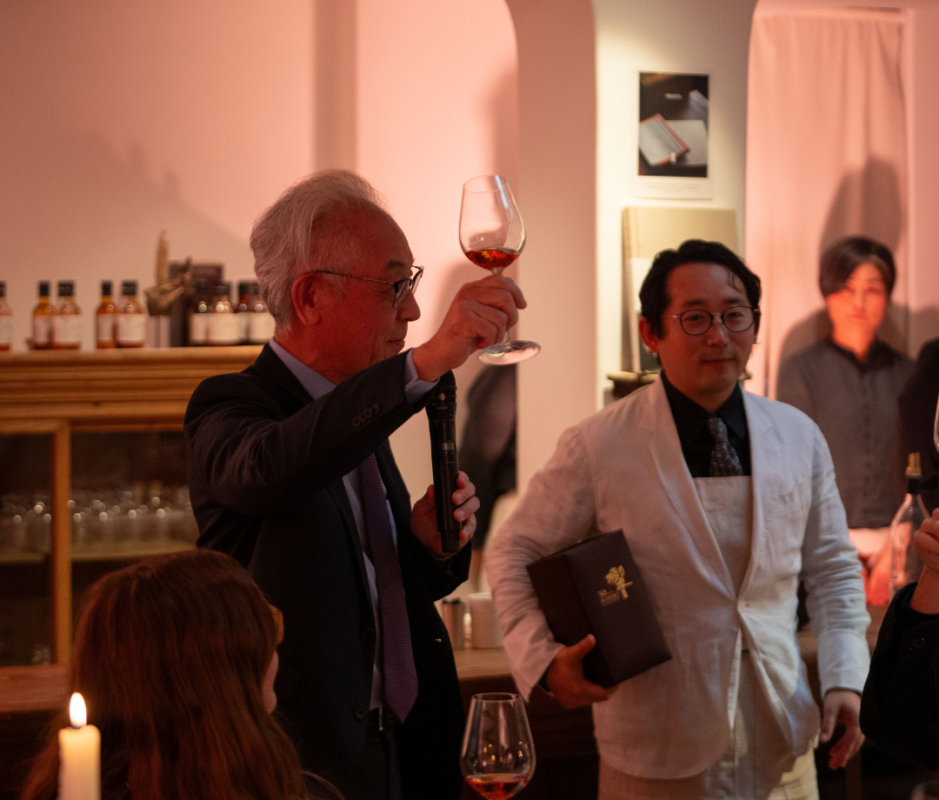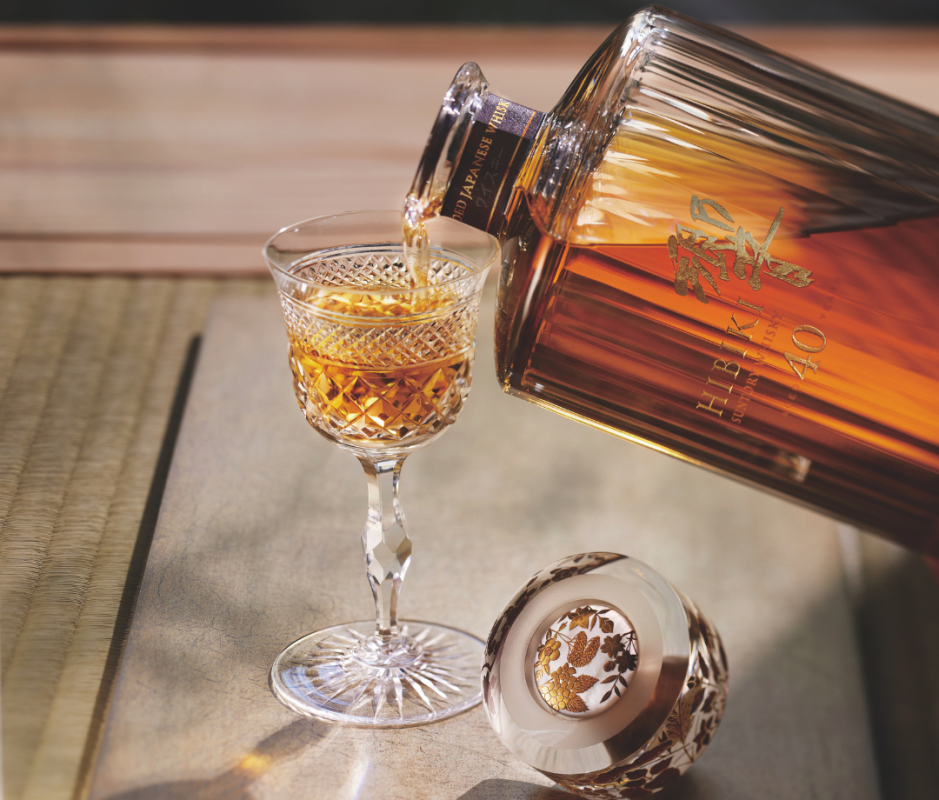Suntory Hibiki whisky was first released in 1989 and has since developed a reputation as the archetype of balance, the characteristic that makes Japanese whisky so exceptional. You may recognize the broad-shouldered cylindrical bottle from the film Lost in Translation, as peddled by Bill Murray. But the new Hibiki 40 is another animal.
I was on hand in Paris for the global reveal of Hibiki 40, and got a chance to sit down with Shinji Fukuyo, Suntory’s fifth-generation chief blender who's been with the company since 1984.
In Japanese whisky, it’s not the distiller, but the blender who's the heart of the process. This release is the oldest retail blend that Fukuyo has made since he started as chief blender in 2009. The challenge of making a blend with such old whisky, he said, was maintaining balance and achieving the fruity top notes that typically come from younger whiskies. The final blend was a combination of five different whiskies from three different distilleries—all of them at least 40 years old:
- Yamazaki malt whiskies from 1978 and 1983, aged in American white oak casks. This gives the blend roundness, body, and some of the brighter notes hard to achieve with old whisky.
- Hakushu lightly peated malt whisky from 1981, which adds a crispness and subtle smokiness to the blend.
- Chita grain whisky, one batch from 1979 and another from 1981, which add a different dimension of flavor and texture, as well as a different sweetness.
- Yamazaki malt whisky from 1980 that was aged from new make in ex-Sherry Spanish oak casks, which give the blend a rich sweetness of dried fruits and a complex nuttiness.
- Yamazaki malt whisky from 1983 that was aged in Japanese Mizunara oak, which adds notes of spice and sandalwood.
These five base whiskies were married for six months prior to bottling at 43 percent ABV.

Courtesy Image
I asked Fukuyo how he knows when he’s got a blend right, when it’s time to stop tinkering.
“I may taste 100 or 200 glasses, but immediately I have some ideas,” he said, adding that “tuning takes time.” But he said that once he decides what the target is for a blend, he and his team all pull together to make it come together.
The life of a chief blender at this level, the absolute highest, is extremely unique. His palate is like a tuning fork onto to which an entire orchestra is keyed, and in many ways, the pressure on his shoulders isn't just from valuable inventory, but the precious irreplaceability of time itself. After all, these whiskies are almost half as old as the company.
Fukuyo feels that pressure “at his back.” He lives by a strict routine in order to maintain a certain baseline palate within himself, waking up every day at 4 a.m. and arriving to work every day by 7:30 a.m. To maintain his tasting consistency, his lunch menu hasn’t changed in 20 years.
“It’s not a scientific approach,” he said. “But emotionally, I would like to rely on something.” On those days when he has a cold or is tired and unsure of his senses, he relies on his team to double and triple check his tasting impressions.
With whiskies that have been on hand for at least four decades, Fukuyo knows them the way coach knows his own bench. Every eight to ten years, each cask is evaluated. If a cask is at risk of being over-matured, its contents are transferred into neutral glassware. If the cask is too empty because of evaporation, they'll combine casks together. So, five old casks may become two, for example.
Because of his team’s cask management duties, Fukuyo already had a mental map of his inventory when it came time to build this blend: “When we did Hibiki 40, we said, ‘OK, that cask, that cask, and that cask,'” he said.
The $35,000 price will ensure that it's a rare luxury for a few. But, for the brand and the category, it’s a mic drop moment a century in the making: luxury Japanese whisky is no longer Scotch's kid sibling.

Courtesy Image
“I know Hibiki 40 has a very high price,” said Fukoyo. “[But] I put in aromas and flavors which are very sophisticated, very gentle. Antique flavors, like when you walk into a very old library or an old house. [When you sip it], you can slowly feel that very emotional atmosphere.”
So, what kind of bottle is worthy of a whisky this rare? Well, they start with a 12-sided wood box made of 12 different types of native Japanese wood. Then, the House of Suntory partnered with Japanese artist Eriko Horiki to hand craft the label for the box. Inside this box, the bottle is made of faceted crystal intricately crafted by a renowned Japanese glassware maker who also supplies the Japanese imperial family. It’s decorated with traditional Japanese maki-e, an artisan lacquer technique, with an inlay of mother-of-pearl and gold in homage to Japanese artistic heritage and tradition.
The bottles are now available for sale in limited quantities in select countries including the U.S., U.K., Germany, France, Spain, Italy, Northern Europe, Australia, Singapore, Taiwan and Global Travel Retail.
Related: How to Drink Whiskey Neat
from Men's Journal https://ift.tt/FyUGYe0
No comments:
Post a Comment